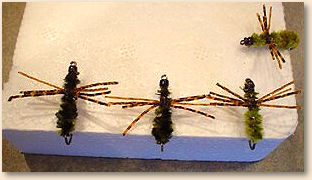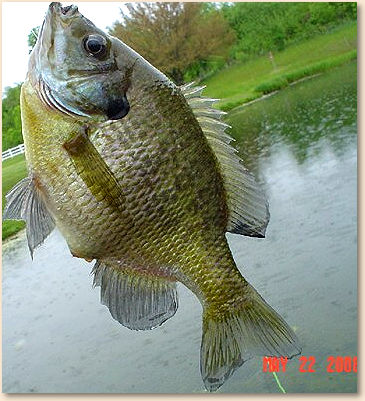|
Another fly that I tied up for the first time this year was a modified
Cap Spider. I modified it by substituting a small glass or plastic
bead on the head of the hook in place of the 1/124oz leadhead
jighead.
I caught a LOT of fish on these flies, including a decent number of
crappies and bass.
Pre-spawn conditions lasted approximately 1.5 months. As soon as
the fish started to move shallow, the bluegills were really starting to
hammer foam surface flies. Although the daytime bite was quite good,
on calm evenings you could cast a foam fly almost anywhere in the pond
and get a good hit within a few seconds! The foam surface flies seemed
even more effective with some rubber legs hanging off of them. Foam
spiders are a good example of an effective foam fly, and I tie up a 2-color
foam 'spider' that also has a short marabou tail. I used a dark grey-colored
foam on the bottom, and a cut-out piece of red or yellow foam on the top.
The bright color on top simply makes the fly easier for me to see. Hey,
it works!

By mid-May, the bull 'gills were starting to move into the shallows and
build nests. I didn't check the water temperatures in the ponds I was
fishing, but the area lakes and streams were sporting water temperature
ranges from about 59°F - 62°F.
One thing I've found is the largest Bull Bluegills seem to be on the
shallowest nests. Walking the shoreline will often send them to
deeper water. Wait a bit and they often come back, but still might
be cautious about hitting your offerings. So, it pays to practice stealth
when approaching the nesting areas.
Usually the bull 'gills are larger than the females, simply because
much of the nutrition both sexes would normally utilize for growth
is instead channeled to creating eggs in the adult females. In one
particular pond I fish, however, I caught bull and female bluegills
that were in the 9" range, which is very good for these public ponds.
When you find the males sitting on the nests, the females will be
very close by, usually just off the nest areas in deeper water. They
will often come to the surface for a foam topwater fly. If not, try
"FishnDave's Flashback," or a #8 or #10 Woolly Bugger.

As you can see, during the pre-spawn and spawning period, the
females will have swollen bellies. They are also identifiable by the
smaller black "opercle" on their gill plate, and duller coloration.
I can't stress enough the importance of releasing the largest bluegills,
especially the nesting bulls. I found an article which makes the case
very clearly. Click the following
link to read the article.
As I'm writing this on May 30, 2008, the bluegills have not spawned
yet. Some of the females are getting absolutely huge with eggs. The
biggest look as though they're getting ready to lay a golf ball!
Best of luck to you when fly-fishing for these fun, scrappy fighters!
~ David "FishnDave" Merical
|





